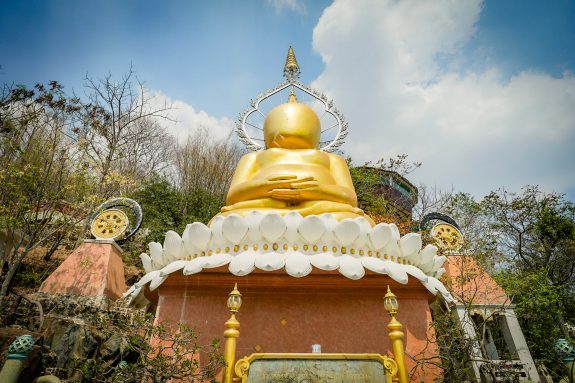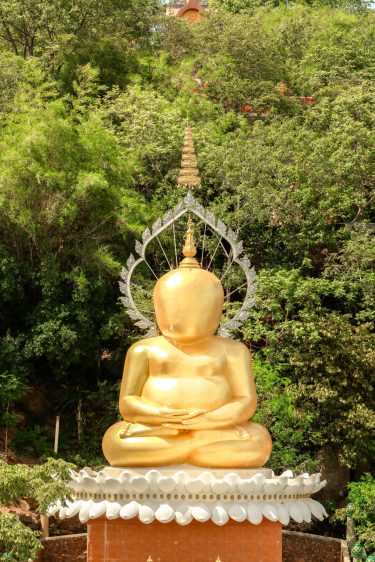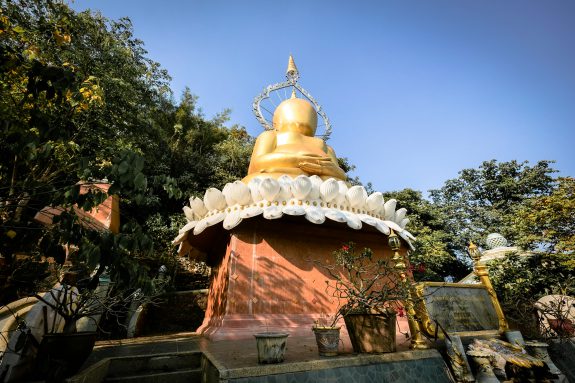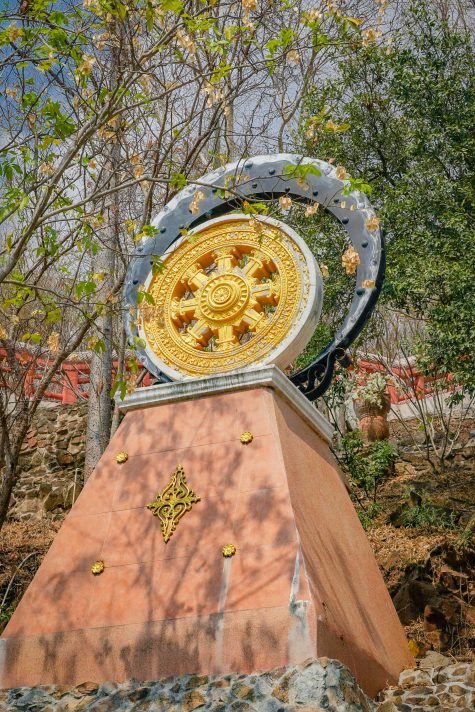Zone 3
The Giant Faceless Buddha and Shrines
Located at the top of the first of the three hills that make up Bodhisattva Mountain,
this zone features 2 notable attractions:
The Giant Faceless Buddha: Phra Pakhawambodi
1. The three-tier lotus flower on which the Faceless Buddha sits represents a threefold practice for enlightenment through which we can break free from the power and effects of suffering/discontentment: precepts or sila (commitments and practices for abstaining from defilements), one-pointedness of mind/state of concentrated calm resulting from meditation or samadhi, and wisdom or panya.
The facelessness of this Buddha is a reminder for us to do things without wanting recognition or social acknowledgment, as well as to uncling from our five senses and to mindfully focus on ourselves in order to develop self-cultivation and inner attunement. Without mindfulness, the five senses stimulate desire and cause suffering/discontentment. In particular, the name Pakhawambodi means one who is magnificent in Buddhist virtues. This quality is reflected in the term pakhawa, which means one who possesses good fortune. Fortune in this context is not monetary. It refers to a cultivated being who is blessed in Buddhist virtues and grace, which can be attained by maintaining our senses—sight, hearing, scent, taste and touch—under mindful-tranquil composure, so even though our senses are functioning, they are no longer stimulants or catalysts for defilements. Consequently, we can break free from impurity and sources of suffering to become a person of great blessings, one with whom people want to keep company.
3. Phra Pakhawambodi’s large round body represents wholesomeness, a key noble characteristic.
4. The Faceless Buddha has been designed to look identical from the front and back sides; he resembles two identical Buddhas sitting back-to-back. This signifies the virtue of being consistently upright. That is, one doesn’t pretend to be virtuous in front of others but then trick them behind their back like a hypocrite.
Double Dharma Wheels
Look closely at the dharma wheel. You’ll see two rings: The outer ring is black and the middle ring is white. The outer black ring symbolizes suffering/discontentment, the state of the universe before the Buddha’s teachings emerged. The dark ring also signifies that dharma arose in the midst of universal suffering, but as human beings, we must not let ourselves remain in that state. We must transform black into white: that which is virtuous, meritorious, and productive. We must cultivate what white stands for as our life’s purpose because when evil and defilements are curtailed, goodness and virtues will emerge to envelop darkness. Ultimately, however, if we come to embody the Buddha’s teaching, we will be able to transcend what is black and what is white. We will reach a state of emptiness, which is symbolized by the air above the white and black rings surrounding dharma wheels. When we are able to internalize the Four Noble Truths, we will reach that state: We will remain above all worldly forces, defilements, and hauntings of impermanence.
The Giant Faceless Buddha: Phra Pakhawambodi
1. The three-tier lotus flower on which the Faceless Buddha sits represents a threefold practice for enlightenment through which we can break free from the power and effects of suffering/discontentment: precepts or sila (commitments and practices for abstaining from defilements), one-pointedness of mind/state of concentrated calm resulting from meditation or samadhi, and wisdom or panya.
The facelessness of this Buddha is a reminder for us to do things without wanting recognition or social acknowledgment, as well as to uncling from our five senses and to mindfully focus on ourselves in order to develop self-cultivation and inner attunement. Without mindfulness, the five senses stimulate desire and cause suffering/discontentment. In particular, the name Pakhawambodi means one who is magnificent in Buddhist virtues. This quality is reflected in the term pakhawa, which means one who possesses good fortune. Fortune in this context is not monetary. It refers to a cultivated being who is blessed in Buddhist virtues and grace, which can be attained by maintaining our senses—sight, hearing, scent, taste and touch—under mindful-tranquil composure, so even though our senses are functioning, they are no longer stimulants or catalysts for defilements. Consequently, we can break free from impurity and sources of suffering to become a person of great blessings, one with whom people want to keep company.
3. Phra Pakhawambodi’s large round body represents wholesomeness, a key noble characteristic.
4. The Faceless Buddha has been designed to look identical from the front and back sides; he resembles two identical Buddhas sitting back-to-back. This signifies the virtue of being consistently upright. That is, one doesn’t pretend to be virtuous in front of others but then trick them behind their back like a hypocrite.
Double Dharma Wheels
Look closely at the dharma wheel. You’ll see two rings: The outer ring is black and the middle ring is white. The outer black ring symbolizes suffering/discontentment, the state of the universe before the Buddha’s teachings emerged. The dark ring also signifies that dharma arose in the midst of universal suffering, but as human beings, we must not let ourselves remain in that state. We must transform black into white: that which is virtuous, meritorious, and productive. We must cultivate what white stands for as our life’s purpose because when evil and defilements are curtailed, goodness and virtues will emerge to envelop darkness. Ultimately, however, if we come to embody the Buddha’s teaching, we will be able to transcend what is black and what is white. We will reach a state of emptiness, which is symbolized by the air above the white and black rings surrounding dharma wheels. When we are able to internalize the Four Noble Truths, we will reach that state: We will remain above all worldly forces, defilements, and hauntings of impermanence.




